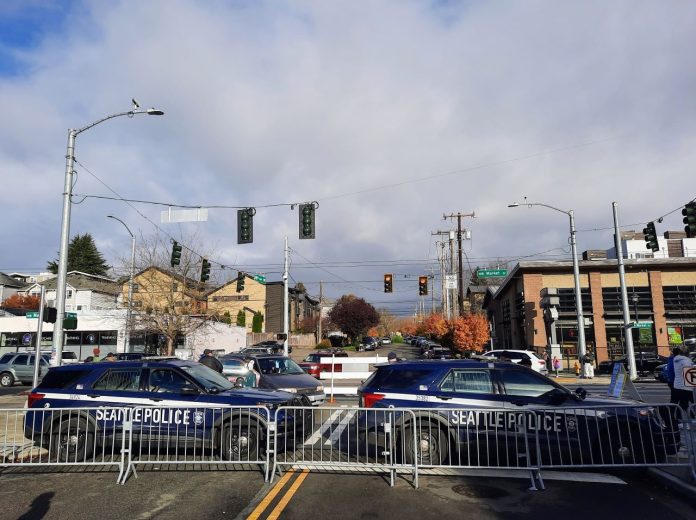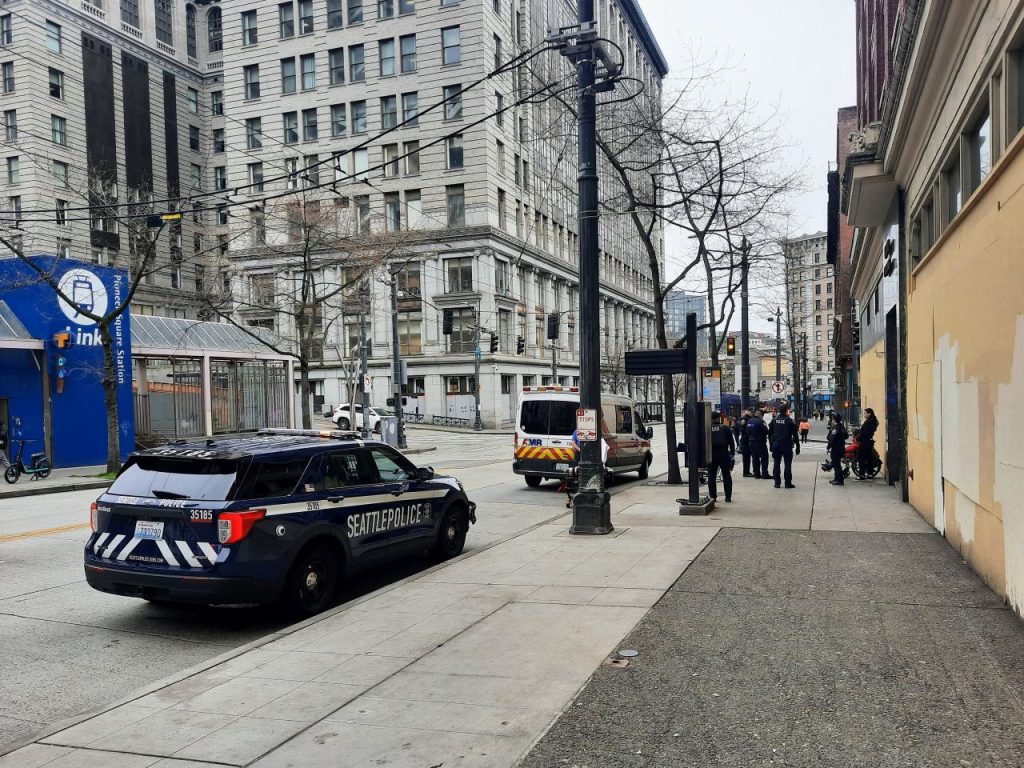
SPD’s refusal to offload low-priority calls is undermining its ability to solve serious crimes.
Over recent decades, the Seattle Police Department (SPD) has increasingly handled fewer serious crimes less efficiently, as I’ve previously explained here. Since 1990, both the number of serious crimes handled per officer per year and the rate at which crimes were solved had dropped, while the department’s budget had increased well above the rate of inflation.
As a result, in 1990, each serious crime handled cost Seattle taxpayers $3,286 and each serious crime solved $15,923. In 2019, in constant dollars the corresponding numbers were at least $8,278 and $93,791, respectively.
Lately, Seattleites have been inundated in claims that SPD is now in a “staffing crisis.”
According to Mayor Harrell’s “Seattle Police Recruitment and Retention Plan,” a decline of 400 sworn officers over the past two and a half years has caused a big problem responding to calls for service. His plan is to hire 500 more officers in order to hit a target of “police officers to population ratio.” However, the plan punts on efficiency and lacks benchmarks about scaling up civilian response.
Having worked in police departments that took reform and police science seriously, I can tell it’s a bad plan. To put a fine point on it: If you assembled a task force of criminals whose objective was to ensure we get “less bang for the buck” from our investments in public safety, they could do worse than coming up with the mayor’s plan.
Busy work is displacing detective work
Let’s start pulling back the curtain on how and why by focusing on one specific statement. Follow-up investigations of serious crime are mostly handled by detectives. Supposedly, “investigations have been negatively impacted because of the need to transfer detectives back to first-response patrol units.”
SPD publishes its computer-aided dispatch (CAD) dashboard online, so let’s take a look at what these detectives have been reassigned to do at the expense of being unable to focus on solving serious crimes.
There are some calls for service where we all very much want to ensure an armed officer with powers of arrest is available: such as a deadly weapon, or an assault in progress.
In 2023 through mid-December, for example, first-response patrol units, including our reassigned detectives, handled 985 “weapon” calls. But they also handled 1.2 times as many — 1,170 – calls about a “non-traffic, non-crime, non-drug casualty.” They handled 250 assaults reported “in progress or just occurred” (which is coded IP/JO).
During the same time period sworn officers also handled 3,280 or just over 13 times as many “hazard” calls that weren’t coded as posing a threat to physical safety. (This despite the fact that if a tree branch or power line is down, neither arresting it nor shooting it will be of much use.)
They handled 151 physical fights reported “IP/JO” versus 36 times as many noise complaints (5,453).
And, finally, they handled 37 robbery or carjacking IP/JO calls – versus 374 times as many (13,854) general crisis or person in a behavioral crisis calls.
If you’re seeing a pattern here, it’s that the mayor and police chief kneecapped the department’s ability to investigate serious crime in order to backfill officers handling calls that don’t require officers to handle.
We know with 100% certainty that they did not need to do this, because other police departments are already using alternative responders to handle these types of calls.
Dissecting low-priority calls
Let’s break the details down, with our starting point a chart of 2023 calls (posted through December 22): 337,094 of them.
Traffic Collisions. “Traffic” is one of the largest call categories. In the Wilmington, North Carolina Police Department civilian crash investigators are responsible for investigating vehicle collisions. (And it is not unique: Fayetteville started doing this in 2007). Offloading motor vehicle collisions is a reduction of on the order of 11,000 calls from the sworn officer and reassigned detective workload.
Crisis Calls. Since 1989, Eugene, Oregon has been using civilian responders for people in crisis. In 2021, they handled more than 16,000 calls. Lately other cities have followed their lead: Denver, Albuquerque, and New York City have deployed alternative responders to a collective total tens of thousands of calls (and counting) without a hitch. Like Eugene, they are finding equal or superior results versus using sworn officers. Offloading crisis calls is a reduction on the order of almost 13,000 calls for service from the sworn officer and reassigned detective workload.

“Police Aide” Tasks. Fifty years ago, the Worcester, Massachusetts Police Department proved that what were then called “police aides” could successfully handle a variety of tasks in lieu of sworn officers with equal citizen satisfaction. These included missing, sick, or injured persons; noise complaints; and stolen, lost, and recovered property or vehicles.
By various titles, many departments continue to employ staff who are uniformed, but without guns or the power of arrest to do the same. In Rio Rancho, New Mexico, “public safety aides” assist motorists and citizens and respond to calls not requiring a police officer. In Anaheim, California, “police services representatives” respond to disturbance calls and impound cars. And in Santa Cruz, “community service officers” take and investigate crime and traffic reports which are low risk in nature or are not in progress, check the security of buildings, and direct traffic.
Tasks that are low hanging fruit to offload include noise (more than 5,000 calls); “crime prevention premise checks” (about 14,000); “property destruction, including damage and graffiti” (more than 5,000); “lost, missing, found or injured persons” and “casualty/sick person” (each about 2,500) and “lost and found property” (just under 2,000).
At more than 33,000 calls, we’re honing in on 10% of the sworn officer and reassigned detective workload – and that’s without digging into the more than 20,000 calls coded “assist public – general.”
After-the-Fact Reporting and Investigation. In Denver, “civilian report technician” share some responsibilities with civilian vehicle crash investigators and police aide-type roles. But they also investigate property crimes, including: “burglaries, motor vehicle thefts, theft from motor vehicles, thefts, criminal mischief, lost/stolen or found property and criminal mischiefs.” Their work includes “evidence collection, photography, latent print processing/recovery/documentation, and swabbing for DNA.”
Most thefts are reported after the fact, because the nature of the beast is that the best way of successfully stealing something is “not to be seen doing it.” Thefts and car prowls account for more than 15,000 calls, and the straightforward answer is “that if the perpetrator is no longer on the scene, a civilian can take a report.” “Mischief or nuisance” accounts for more than 6,000. Civilian investigators could offload on the order of 20,000 calls for service from sworn officers and reassigned detectives.
Across these roles and the parking enforcement officers (PEOs) the department already has, we can also pull more than 10,000 parking violations off their plate.
Solving serious crimes requires a new approach
In this context, “officers per capita” is a metric that’s beyond meaningless, because what officers are doing matters.
This analysis itself (that identified between a quarter to a third of calls that map to real civilian job descriptions “from the bottom” up) has been conservative for the sake of clarity. We know from a city commissioned study that SPD officers have been spending a majority of their time on non-criminal matters, with nearly half of all calls for service amenable to alternative response.
Mayor Harrell and Chief Diaz have had years to adapt to a nationwide shortage of police officers and the department’s “less for more” economics simply by emulating what other departments have been doing for a long time. One might hope that tens of millions in overtime paid to sworn officers annually would be focused on solving serious crimes, but in reality, much of it isn’t and instead goes toward menial jobs like directing traffic at major events and low-priority calls that could be addressed by civilians if laws and labor contracts allowed it.
There’s no time like the present to start – especially when the mayor’s proposed plan relies on signing bonuses (from $7,500 to as much as $30,000) that make expensive armed officers even more costly. That cost control issue could get worse since newly-installed City Council President Sara Nelson quickly floated pay raises for police officers as a first priority item. We should all demand Mayor Harrell and Council refuse to eyes-wide-open throw good money after bad.

Bryan Kirschner
Bryan Kirschner works in technology and lives in Wallingford.
